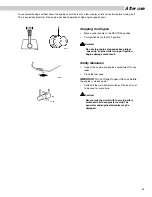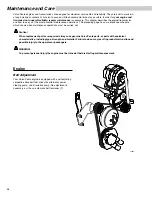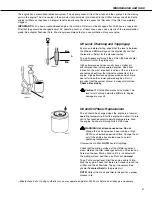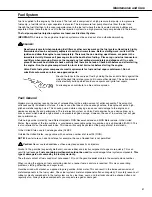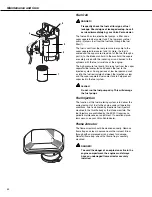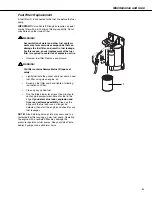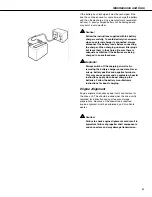
51
Fuel System
Fuel is supplied to the engine by the fuel cell. The fuel cell is comprised of a high pressure fuel pump, a low pressure
fuel pump, a fuel filter and a vapor separator fuel cooler. The low pressure fuel pump draws fuel from the fuel tank
through the fuel filter then to the vapor separator area in the fuel cell where the fuel is cooled and any bubbles are
separated. From there the fuel is sent to the fuel injection system via a high pressure fuel pump included in the fuel cell.
The fuel pump and fuel injection system are fused, see Electrical System
.
IMPORTANT!
All work on the engine fuel injection system must be carried out at an authorized workshop.
DANGER!
Be extremely careful when replacing fuel filters or other service work on the fuel system. Gasoline is highly
flammable and can be extremely explosive in certain circumstances. Before starting work: switch off the
ignition and allow the engine to cool completely. There must be no smoking, open flames, or sparks in the
immediate vicinity. Remove all passengers from the boat before fueling. Place a rag under fuel connectors
and filters when removing. Remove the rag and any fuel spillage immediately and dispose of it in a safe
place. When work has finished: check carefully that there are no leaks. Check both before and after starting
the engine. Run the engine compartment fan for at least 4 minutes before starting the engine.
Volvo Penta fuel system components meet requirements for fuel and fuel vapor containment. Do not
substitute automotive or other non-approved parts.
Ground the tanks to the source of fuel by holding the hose nozzle firmly against the
side of the deck filler plate or ground it in some other manner. This action prevents
static electricity buildup which could cause sparks and ignite fuel vapors.
Fuel leakage can contribute to a fire and/or explosion.
Fuel: General
Modern marine engines require the use of unleaded fuel with a certain amount of antiknock quality. The amount of
antiknock quality is defined as Octane. If a fuel is used that does not have enough octane, the engine will emit a high-
pitched metallic rapping noise. This knocking sound while annoying also cases real damage to the engine and
decreases engine life and performance. The fuel injection system on Volvo Penta engines have a device know as a
knock sensor which detects engine knock and prevents engine damage. However, the use of low octane fuel will give
poor performance.
Octane in gasoline is rated by two different methods. RON Research octane and MON Motor octane. In the United
States, the average of the two numbers is considered a reasonable guide for gasoline and is abbreviated (R+M)/2. This
is also referred to as the antiknock index. This index will usually be posted on the pump at most fuel stations.
In the United States, use 89 octane gasoline (R+M)/2.
Outside the United States, use gasoline with an octane number of at least 93 (RON).
NOTE!
In certain areas, Lake Constance for example, the use of leaded fuel is not permitted.
Caution!
Never use lead additives as these may leave deposits on injectors.
Alcohol in the gasoline (especially methanol), causes rubber and plastic components to age more quickly. This can
result in fuel leakage.
Fuels containing methanol should not be used
to avoid damage to fuel system components.
This
type of damage is not covered by the factory warranty.
The ethanol content of fuels used must not exceed 10% and the gasoline
must
maintain the correct octane number.
When running the engine on fuels containing alcohol, a leaner fuel air mixture is required. This may cause idling
problems, starting difficulties and vapor locks.
Gasoline mixed with alcohol, as opposed to pure gasoline, binds water. This can result in the increased corrosion of
metal components in the fuel system. Check fuel system’s metal componenets often and regularly. For safety reasons, all
rubber or plastic components in the fuel system such as fuel lines, seals, and fuel tanks should be checked often and
regularly also. Always replace components you suspect are aged or damaged.
Maintenance and Care
Summary of Contents for 5.7 Gil-B
Page 2: ......
Page 15: ...13 Features 3 11 17 6 7 15 6 7 8 10 3 11 3 11 18 20 5 4 19 3590874 S 3590874 S ...
Page 17: ...15 Features 3 11 17 6 7 15 6 7 8 10 3 11 3 11 18 20 3 11 5 4 3590875 S 3590875 T 19 ...
Page 19: ...17 Features 3 11 17 6 7 15 6 7 8 10 3 11 3 11 4 18 20 3590873 S 5 19 3590873 T ...
Page 21: ...19 Features 3 11 17 6 7 15 18 6 7 8 10 3 11 3 11 19 20 3590877 S 3590877 T 5 4 ...
Page 23: ...21 Features 17 6 7 15 6 7 8 3 11 10 3590879 T 3590879 S 3 11 5 4 19 18 3 11 5 20 ...
Page 25: ...23 Features 17 6 7 15 6 7 8 3 11 10 3590880 T 3590880 S 3 11 5 4 19 18 3 11 5 20 ...
Page 27: ...25 Features 17 6 7 15 6 7 8 3 11 10 3590883 T 3590883 S 3 11 5 4 19 18 3 11 5 20 ...
Page 29: ...27 Features 17 6 7 15 6 7 8 3 11 10 3590881 T 3590881 S 3 11 5 4 19 18 3 11 5 20 ...
Page 31: ...29 Features 3 11 17 6 7 15 6 7 8 10 3 11 18 5 5 19 3 11 4 20 3590884 T 3590884 S ...
Page 69: ......
Page 70: ...7742239 English 10 2002 ...







